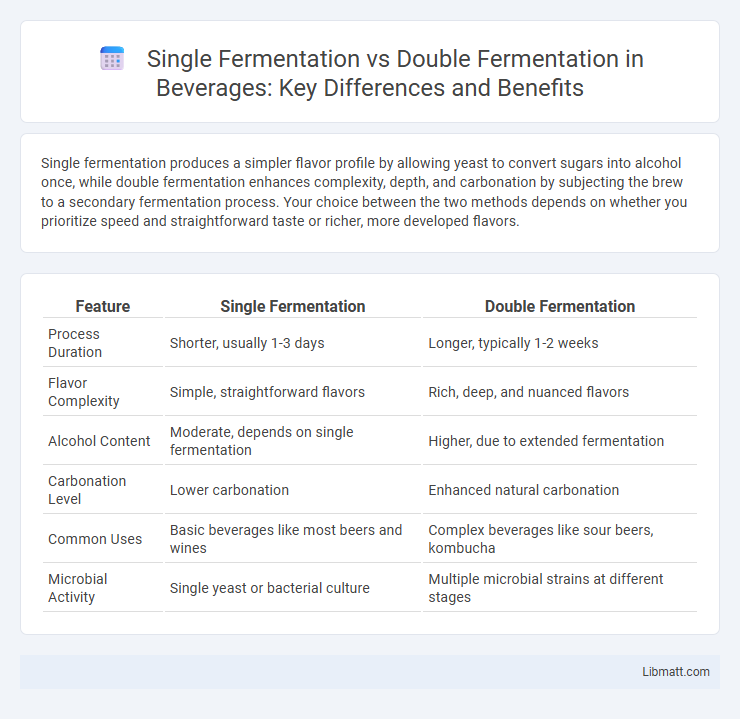Single fermentation produces a simpler flavor profile by allowing yeast to convert sugars into alcohol once, while double fermentation enhances complexity, depth, and carbonation by subjecting the brew to a secondary fermentation process. Your choice between the two methods depends on whether you prioritize speed and straightforward taste or richer, more developed flavors.
Table of Comparison
| Feature | Single Fermentation | Double Fermentation |
|---|---|---|
| Process Duration | Shorter, usually 1-3 days | Longer, typically 1-2 weeks |
| Flavor Complexity | Simple, straightforward flavors | Rich, deep, and nuanced flavors |
| Alcohol Content | Moderate, depends on single fermentation | Higher, due to extended fermentation |
| Carbonation Level | Lower carbonation | Enhanced natural carbonation |
| Common Uses | Basic beverages like most beers and wines | Complex beverages like sour beers, kombucha |
| Microbial Activity | Single yeast or bacterial culture | Multiple microbial strains at different stages |
Introduction to Fermentation Processes
Single fermentation involves one continuous fermentation stage, where yeast or bacteria convert sugars into alcohol or acids, producing distinct flavors typical in products like cider or certain beers. Double fermentation includes an additional fermentation phase, enhancing complexity by allowing secondary microbes or yeast to further develop aromas, alcohol content, and texture, commonly used in styles like lambics or sparkling wines. Understanding these fermentation processes helps you tailor production methods to achieve desired taste profiles and qualities in your beverage.
What is Single Fermentation?
Single fermentation is a process in brewing or baking where yeast ferments sugars once to produce alcohol or carbon dioxide, resulting in a faster production time and simpler flavor profile. This method is commonly used in American ales and many bread recipes, emphasizing efficiency and consistency. It contrasts with double fermentation, which involves a secondary fermentation stage to develop more complex flavors and improved carbonation.
What is Double Fermentation?
Double fermentation is a process where a beverage or dough undergoes two separate fermentation stages to develop more complex flavors and enhanced texture. The first fermentation allows primary sugar conversion by yeast or bacteria, while the second fermentation usually refines taste, increases carbonation, or matures the product by secondary microbial activity. This method is commonly used in brewing beer, making sourdough bread, and fermenting kombucha for improved depth and quality.
Key Differences: Single vs Double Fermentation
Single fermentation involves one primary fermentation phase where yeast converts sugars into alcohol and carbon dioxide, resulting in a simpler flavor profile and shorter production time. Double fermentation includes an initial fermentation followed by a second fermentation, often in the bottle or secondary vessel, enhancing complexity, carbonation, and depth of flavor. This process is common in producing sparkling wines and certain beers, emphasizing richer taste and refined texture compared to single fermentation products.
Microbial Activity in Fermentation Stages
Single fermentation primarily involves one dominant microbial activity, often yeast or a specific bacteria, converting sugars into alcohol or acids in a single stage. Double fermentation introduces a second microbial phase, where different microorganisms, such as lactic acid bacteria following yeast fermentation, modify the product further, enhancing flavor complexity and acidity. This sequential microbial activity in double fermentation intensifies biochemical transformations, improving product stability and organoleptic properties compared to single fermentation.
Impact on Flavor and Texture
Single fermentation typically produces a fresh, mild flavor with a softer texture due to shorter fermentation time and less complex biochemical changes. Double fermentation enhances flavor complexity by allowing additional fermentation stages, resulting in tangier, more developed tastes and a chewier, denser texture. The extended fermentation also increases acidity and carbonation, contributing to a richer mouthfeel and prolonged shelf life.
Health Benefits and Nutritional Profiles
Single fermentation typically preserves more natural probiotics and enzymes, enhancing digestion and gut health, while double fermentation boosts the concentration of beneficial bacteria and antioxidants, offering stronger immune support. The extended fermentation in double fermentation also often results in lower sugar content and higher levels of B vitamins, which contribute to improved metabolism and energy production. Your choice between single and double fermentation affects the depth of probiotic variety and nutrient density, impacting overall health benefits.
Common Foods and Beverages Using Each Method
Single fermentation is commonly used in foods and beverages like yogurt, sauerkraut, sourdough bread, and beer where a single microbial culture converts sugars into desired products. Double fermentation is typical in beverages such as kombucha and certain types of sourdough or traditional beers, where a secondary fermentation enhances flavor, carbonation, or acidity. Your choice between single and double fermentation affects the complexity, texture, and taste of the final product based on the specific microbes involved and fermentation duration.
Challenges and Considerations in Fermentation
Single fermentation typically offers a faster process with simpler control, but may present challenges in achieving complex flavors and thorough yeast activity. Double fermentation involves extended time and stricter monitoring, often resulting in enhanced taste profiles and improved carbonation, yet requires careful management to prevent contamination or over-fermentation. Your choice depends on balancing production speed against desired quality and the specific characteristics of the fermented product.
Choosing the Right Fermentation Technique
Single fermentation involves one continuous fermentation process, ideal for producing lighter, fresher flavors in beverages like beer or bread. Double fermentation, often used in styles such as Belgian ales or sourdough bread, enhances complexity and carbonation by introducing a secondary fermentation phase. Selecting the right fermentation technique depends on desired flavor profiles, fermentation time, and final product characteristics.
Single fermentation vs double fermentation Infographic

 libmatt.com
libmatt.com